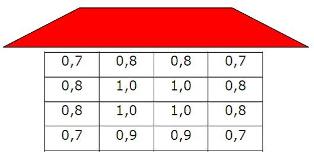+372 6799 361
The corrective coefficients on the basis of the location of the apartments

One of the conditions for the just and honest calculation of heat costs in case of individual heat metering systems is the application of corrective coefficients. Their objective is to balance the possibilities of the users of apartments that are at a locational disadvantage from the standpoint of heating (e.g. corner apartments, first or last floor). The corrective coefficient defines in an understandable way for the inhabitants, to which degree his/her apartment is at a locational disadvantage in comparison with the “warmest” apartment in the building, which corrective coefficient is 1.0.
The experiences from many countries show that such coefficients are defined differently in different countries. E.g. in Germany they are currently hardly ever used, but in Poland they are extremely frequent. The method for the defining of the corrective coefficient is based on the comparative analysis of the actual heat requirement coefficient calculated on the basis of the central heating project. This has been worked out at the Scientific Research Centre for Installation Systems INSTAL (Germany). And we have two options here:
A. The heat requirement has been defined on the basis of the preliminary central heating project. This means that a preliminary central heating installation project is developed. Thereat it must be taken into account that the planners have probably been guided by the obligatory legal acts in force at the time, without taking into account the future modernisation. The corrective coefficient is defined on the basis of the warmest apartment, which coefficient shall be defined as 1.0. In case of this method, which is more accurate than the simple use of a table, makes data difficult to process at times, since not all building managers have not preserved the house projects, especially when they have been built a long time ago. It should be further pointed out that during that time the inhabitants may have replaced the radiators, and may have installed radiators that do not always satisfy the heat requirements of the specific apartment. And finally, the building may be restored, which also affects its comfortable heating.
B. The heat requirement has been defined on the basis of the buildings new central heating project. The whole system of the building is replanned for achieving the correct metering, thereby taking into account factors like insulation of the building, replacing the windows and the building’s other characteristics, which objective has been to increase the comfortable heating of the building. At the present moment, this is the most exact method. But at this point one has to over come the issue, where the inhabitants have replaced the radiators and they are not in accordance with the heat requirements of the apartment. The heat requirement coefficients of the rooms are calculated for the comparative analysis in the following way:

qi – heat requirement coefficient of the radiators in the utilisation unit i [W/m2];
Qpom, j – heat requirement for the radiator j [W];
Qpp,j – heat capacity of the input and backflow standpipes on the radiator j [W];
Qpj – heat capacity of other (excl. standpipes) uninsulated central heating cables in the observed room on the radiator j [W];
Fi – surface area of the utilised unit i [m2];
n – number of radiators in the utilised unit;
Utilised unit – room.
- Kadaka tee 181, 12618 Tallinn
- +372 6799 361
- info@optimatic.ee


